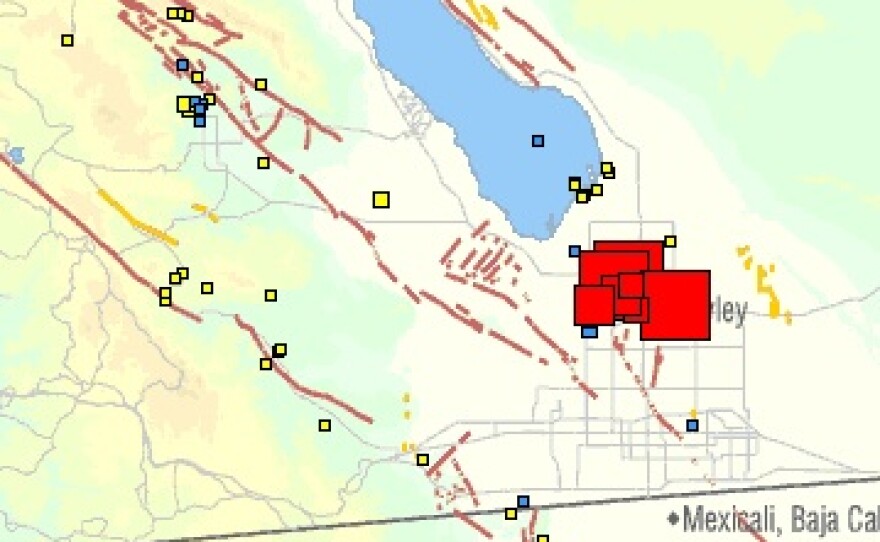A rash of moderate quakes shook the south end of the Salton Sea on Sunday, and the largest quakes were felt from Orange County and San Diego east into Arizona.
What To Do During An Earthquake
If Indoors
- DROP to the ground; take COVER by getting under a sturdy piece of furniture; and HOLD ON until the shaking stops.
- Stay away from glass, windows, outside doors and walls, and anything that could fall, such as lighting fixtures or furniture.
- Stay in bed if you are there when the earthquake strikes. Hold on and protect your head with a pillow, unless you are under a heavy light fixture that could fall. In that case, move to the nearest safe place.
- Do not use a doorway except if you know it is a strongly supported, load-bearing doorway and it is close to you. Many inside doorways are lightly constructed and do not offer protection..
- Stay inside until the shaking stops and it is safe to go outside. Do not exit a building during the shaking. Research has shown that most injuries occur when people inside buildings attempt to move to a different location inside the building or try to leave.
- DO NOT use the elevators.
- Be aware that the electricity may go out or the sprinkler systems or fire alarms may turn on.
If Outdoors
- Stay there.
- Move away from buildings, streetlights, and utility wires.
- Once in the open, stay there until the shaking stops. The greatest danger exists directly outside buildings, at exits and alongside exterior walls. Many of the 120 fatalities from the 1933 Long Beach earthquake occurred when people ran outside of buildings only to be killed by falling debris from collapsing walls. Ground movement during an earthquake is seldom the direct cause of death or injury. Most earthquake-related casualties result from collapsing walls, flying glass, and falling objects.
"What we're seeing is a classic Brawley seismic swarm,'' USGS seismologist Lucy Jones told City News Service. "We haven't seen one of these since the 1970s, and there was another one back in the 1930s.''
Some buildings were evacuated in Brawley, a small farm town 115 miles east-northeast of San Diego. "It's pretty bad, we had to evacuate the hotel just for safety,'' said Rowena Rapoza, office manager at the Best Western Hotel there.
Approximately 30 mobile homes in Brawley we're knocked off their foundations, and there were some reports of water and power outages, according to Elizabeth Enriques Phillips, Imperial Valley Liaison for the American Red Cross.
Jones said USGS seismographs and analysis computers were overwhelmed by the rash of rattling that began at sunrise, and reached a crescendo with a magnitude 5.3 quake just after 12:30 p.m. It was followed by a 4.9 shaker within two minutes.
"Our system is choking on so many earthquakes,'' Jones said. "This area of California is deep soils, and we do not get as precise data as we do over the rest of the state, and that makes our data a little less precise.''
Preliminary computerized USGS reports had indicated that three quakes larger than magnitude 5.3 had rattled out from Brawley at 12:30. That was later resolved by seismologists to two quakes, magnitude 5.3 and 4.9, Jones told CNS.
The quakes were strongly felt at Borrego Springs, in San Diego County about 25 miles west of the epicenter. "We've felt shaking for sure, but electricity has not gone out,'' said Gwenn Marie, owner of the Borrego Valley Inn.
The quakes were felt over all of San Diego, Riverside and Imperial counties, and in Yuma and La Paz counties in Arizona, according to a USGS registry.
Southern California Edison declared an "unusual event'' as the quakes were felt in the control room of the San Onofre Nuclear Generating Station's twin reactors. Both of those nuclear piles have been in secure shutdown mode all summer, while federal and state officials work with the utility to discover why a recent upgrade and expansion caused parts of the boilers to shake violently.
SC Edison said the notification was a standard step requited by the federal government.
The ground about 5 miles north-northwest of Brawley began to spasm at sunrise, and Brawley was rocked by a magnitude 3.9 quake at 10:02 a.m., followed by a 3.4 quake about 90 seconds later.
In the three hours after the first earthquakes, an additional 11 quakes struck the same approximate epicenter near the Salton Sea. Quakes with magnitudes of 4.0, 4.0. 4.6 and 4.7 reportedly also hit during the noon hour.
The apparent quake cluster was centered 3 miles north-northwest of Brawley, 16 miles north of El Centro and about 115 miles east-northeast of San Diego. Some of the quakes may have been just east of Brawley.
Jones said the quake swarm was about midway between fault complex on the west side of the Imperial Valley, and the main branch of the San Andreas Fault, which runs from near Palm Springs to enter Mexico just west of Yuma.
"These don't seem to be related to earthquakes on the San Andreas itself, other than in a general way,'' she said. "It's pretty far away.''
Jones says she expected the quake swarm "to continue to bubble along, they're going to get a bunch of 4s and 5s.''
By midafternoon, the automated USGS lists were lengthy with reports of dozens of quakes echoing out from within 8 miles of Brawley. Jones has emphasized that many of the reported quakes are duplicates or have unreliable magnitudes, given the nature of the geology of the Brawley area.






